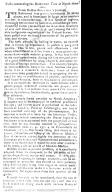[ Facts Concerning the Butternut Tree of North-America ] Dr. William James Almon
Date: Late 18th century; exact date unknown.
Source:
Manuscript Notebook of Dr. William James Almon
Institution: Nova Scotia Archives
| Source Origin: Almon Family Fonds
| Reference: MG 1 / Microfilm Reel 10,045
An account of the medical usefulness of butternut tree bark in treating a variety of ailments. Unique to North American medical practice, the decocted buttermilk bark widely used in domestic medicine was also employed by civilian physicians and apothecaries as well as the continental army. The bark is known to be useful also for dying cloth. Newspaper clipping, p. 157.
"Facts Concerning the Butternut Tree of North America" from Dr. Mitchel's Journal appeared several times in American newspapers in 1788:
The Pennsylvania Packet, and Daily Advertiser, Philadelphia, 6 September 1788;
The New-Haven Gazette, and Connecticut Magazine, New Haven, 18 September 1788;
Thomas's Massachusetts Spy; or The Worcester Gazette, Worcester, 25 September 1788;
The New Hampshire Gazette, and the General Advertiser, Portsmouth, 2 October 1788;
City Gazette And Daily Advertiser, Charleston, 6 October 1788;
The United States Chronicle: Political, Commercial and Historical, Providence, 9 October 1788;
The Federal Gazette, and Philadelphia Post, Philadelphia, 11 October 1788;
The Weekly Monitor, Litchfield, 20 October 1788;
American Museum: Or Repository & Modern Fugitive Pieces Etc. Prose and Poetica, Vol. 4 ,Issue 5, 1 November 1788 (p. 435-36);
The Berkshire Chronicle, Pittsfield, 19 December 1788.
None of these appear to be the direct source for Dr. Almon's clipping, however (the typography of his clipping is different; perhaps there are printings not included in the America Historical Newspapers and American Antiquarian Society (AAS) Historical Periodicals Collection databases).
Facts concerning the Butternut Tree of North-Ame-
rica.
From Doctor MITCHEL’S Journal.
THE Butternut tree grows luxuriantly in many
places, and is sometimes so large as to measure
ten feet in circumference. It is a specie of juglans,
seemingly not noticed by Linnaeus, and although men-
tioned by Cutler (memoirs of the American Acadamy
of arts and sciences, vol. I. p. 490) among the valu-
able indigenous vegitables of the United States, has
been passed over without a narrative of its particular
uses and virtues.
The bark affords, by boiling in water, an extract
that is found, by experience, to possess a purgative
quality. This is safe, gentle and efficatious; and
when administered in doses, from 15 to 40 grains, op-
erates downwards without griping. It was much used
in the continental army, during the late war, and prov-
ed a good substitute for jalap, rhubarb, and other ca-
therties of foreign production. The country people,
in several districts, keep it for their families and pre-
scribe it as a domestick medicine; Some of them
have even been profitable busied in preparing the ex-
tract for sale, to practitioners of physick, apothecaries
and house-keepers, both in this country and abroad.
It is an excellent medicine in those diseases where
gentle purges and mild catharties are proper, and
therefore it is said to have been remarkably service-
able in dysenteries, haemorrhoids, gonorrhaeas and o-
ther ailments.
This remedy seems peculiar to North-America;
it appears not to be employed in medical practice in
Europe; and I never knew it prescribed in the infir-
maries at London, Paris or Edinburgh; nor has it
been received into any of the pharmacopeias. No
mention is made of it even by the laborious Triller,
who writes indeed concerning the Nuces Juglandes,
but seems so unacquainted with the properties of this
tree, that he has entirely omitted it (Dispensator.
Pharmacent. tom. I. p. 197. 4 to Francofurti ad
Moenum, 1763)--Nor is any thing said about it by
Lewis. (Experimental history of the Materia Medica.)
But it certainly claims highly the attention of the
European physicians, and if procured and administered,
there is no doubt that it would be ever after consider-
ed by them, a choice article of Materia Medica.
Besides its use in private practice, it is excellently
adapted, from its cheapness, to the purposes of hos-
pitals, dispensaries, navies and camps. If then phy-
sicians and surgeons, in foreign countries, can be en-
couraged to prescribe this extract to their patients,
they will not only bring into vogue an useful medi-
cine, but will likewise make it a lucrative article of
commerce, for exportation from this quarter of the
globe.
It needs scarcely to be mentioned, that the nut of
this tree is very rich, esculent and oily; and that the
bark is used for dying cloth with various shades of
brown.
Download: Transcription | Images
